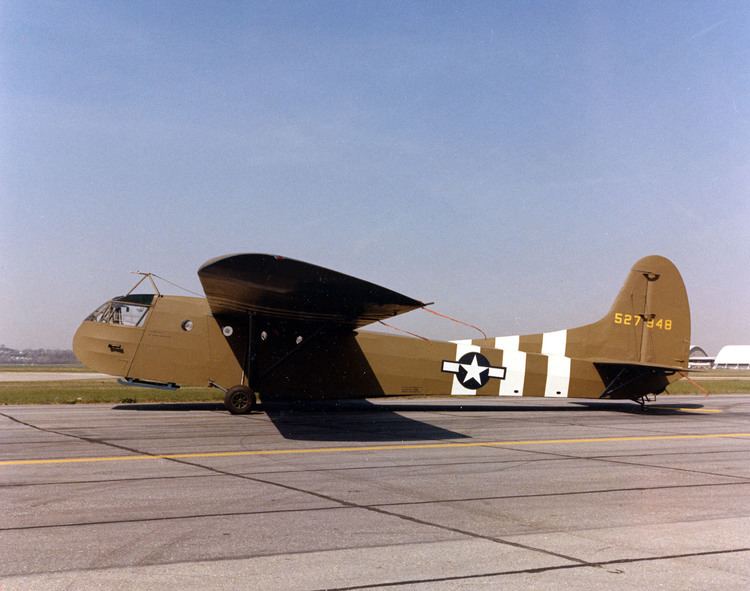Top speed 240 km/h Wingspan 26 m Number built >13,903 | Weight 1,769 kg Length 15 m Engine type Reciprocating engine | |
 | ||
The Waco CG-4A was the most widely used American troop/cargo military glider of World War II. It was designated the CG-4A by the United States Army Air Forces, and named Hadrian (after the Roman emperor) in British military service.
Contents
- Waco cg 4 gliders c 47s and jumpers
- Design and development
- Production
- Operational history
- Variants
- Operators
- Accidents and incidents
- Surviving aircraft
- Specifications CG 4A
- References
Designed by the Waco Aircraft Company, flight testing began in May 1942, and eventually more than 13,900 CG-4As were delivered.
Waco cg 4 gliders c 47s and jumpers
Design and development
The CG-4A was constructed of fabric-covered wood and metal and was crewed by a pilot and copilot. It had two fixed mainwheels and a tailwheel.
The CG-4A could carry 13 troops and their equipment. Cargo loads could be a 1⁄4ton truck (i.e. a Jeep), a 75 mm howitzer, or a 1⁄4ton trailer, loaded through the upward-hinged nose section. C-47s were usually used as tow aircraft. A few C-46 tugs were used during and after Operation Plunder.
The USAAF CG-4A tow line was 11⁄16-inch-diameter (17 mm) nylon, 350 feet (107 m) long. The CG-4A pickup line was 15⁄16inch- (24 mm)-diameter nylon, but only 225 ft (69 m) long including the doubled loop.
In effort to identify areas where strategic materials could be reduced, a single XCG-4B was built at the Timm Aircraft Corporation using wood for the main structure.
Production
From 1942-1945, the Ford Motor Company's Kingsford plant built 4,190 Model CG-4A gliders for use in combat operations during World War II. The Kingsford plant built more CG-4A gliders than any other company in the nation at much less cost than other manufacturers. The primary builders of the Model CG-4A gliders were located in Troy, Ohio; Greenville, Michigan; Astoria, New York; Kansas City, Missouri; St. Paul, Minnesota; and Kingsford, Michigan.
The 16 companies that were prime contractors for manufacturing the CG-4A were:
The factories ran 24-hour shifts to build the gliders. One night-shift worker in the Wicks Aircraft Company factory in Kansas City wrote,
Operational history
Whiteman Air Force Base was originally activated on 6 August 1942 as Sedalia Glider Base. In November 1942 the installation became Sedalia Army Air Field and was assigned to the 12th Troop Carrier Command of the United States Army Air Forces. The field served as a training site for glider pilots and paratroopers. Assigned aircraft included the CG-4A glider, Curtiss C-46 Commando, and Douglas C-47 Skytrain. The C-46 was not used as a glider tug in combat, however, until Operation Plunder (the crossing of the Rhine) in March 1945.
CG-4As went into operation in July 1943 during the Allied invasion of Sicily. They were flown 450 miles across the Mediterranean from North Africa for the night-time assaults such as Operation Ladbrooke. Inexperience and poor conditions contributed to the heavy losses. They participated in the American airborne landings in Normandy on 6 June 1944, and in other important airborne operations in Europe and in the China Burma India Theater. Although not the intention of the Army Air Forces, gliders were generally considered expendable by high-ranking European theater officers and combat personnel and were abandoned or destroyed after landing. While equipment and methods for extracting flyable gliders were developed and delivered to Europe, half of that equipment was rendered unavailable by certain higher-ranked officers. Despite this lack of support for the recovery system, several gliders were recovered from Normandy and even more from Operation Market Garden in the Netherlands and Wesel, Germany.
The CG-4A found favor where its small size was a benefit. The larger British Airspeed Horsa could carry more troopers (seating for 28 or a jeep or an anti-tank gun), and the British General Aircraft Hamilcar could carry 7 tons (enough for a light tank), but the CG-4A could land in smaller spaces. In addition, by using a fairly simple grapple system, an in-flight C-47 equipped with a tail hook and rope braking drum could "pick up" a CG-4A waiting on the ground. The system was used in the 1945 high-elevation rescue of the survivors of the Gremlin Special 1945 crash, in a mountain valley of New Guinea.
The CG-4A was also used to send supplies to partisans in Yugoslavia.
After World War II ended, most of the remaining CG-4As were declared surplus and almost all were sold. Many were bought for the wood in the large shipping boxes. Others were bought for conversion to towed camping homes with the wing and tail end cut off and being towed by the rear section and others sold for hunting cabins and lake side vacation cabins.
The last known use of the CG-4A was in the early 1950s by the USAF with an Arctic detachment aiding scientific research. The CG-4As were used for getting personnel down to, and up from, floating ice floes, with the glider being towed out, released for landing, and then picked up later by the same type of aircraft, using the hook and line method developed during World War II. The only modification to the CG-4A was the fitting of wide skis in place of the landing gear for landing on the Arctic ice floes.
Variants
Operators
Accidents and incidents
Surviving aircraft
Specifications (CG-4A)
Data from Aviation Enthusiasts Corner and Pilot's Flight Operating Instructions for Army Model CG4A Glider (TO No. 09-40CA-1)
General characteristics
"Troop Carrier (2 crew & 13 passengers): 4,197 pounds (1,904 kg)";"Cargo Carrier - Jeep (2 crew, 4 passengers, 1 Jeep Car): 4,197 pounds (1,904 kg)""Cargo Carrier - 75 MM howitzer (2 crew, 3 passengers, 1 Howitzer, 18 rounds ammunition): 4,197 pounds (1,904 kg) ()
Performance
Armament
none
